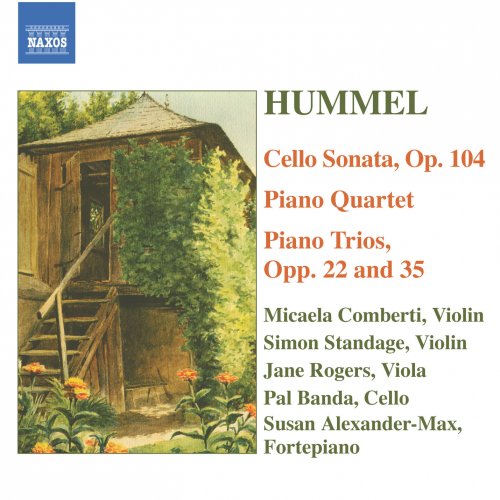
Susan Alexander-Max, Micaela Comberti, Jane Rogers, Simon Standage - Hummel: Piano Trios, Piano Quartet in G major, Cello Sonata (2005)
BAND/ARTIST: Susan Alexander-Max, Micaela Comberti, Jane Rogers, Simon Standage
- Title: Hummel: Piano Trios, Piano Quartet in G major, Cello Sonata
- Year Of Release: 2005
- Label: Naxos
- Genre: Classical
- Quality: FLAC (tracks)
- Total Time: 01:09:15
- Total Size: 328 Mb
- WebSite: Album Preview
Tracklist:
Piano Quartet In G Major, Op. Posth. (17:18)
1. Andante Cantabile 5:32
2. Allegro Con Spirito 11:45
Piano Trio In G Major, Op. 35 (15:12)
3. Allegro Con Brio 7:39
4. Tempo Di Menuetto 3:38
5. Rondo: Vivace E Scherzando 3:55
Grande Sonate In A Major For Cello And Piano, Op. 104 (23:26)
6. Allegro Amabile E Grazioso 11:13
7. Romanza: Un Poco Adagio E Con Espressione 5:48
8. Rondo: Allegro Vivace Un Poco 6:24
Piano Trio In F Major, Op. 22 (13:26)
9. Allegro Moderato 5:26
10. Andante Con Variazioni 4:14
11. Rondo: Alla Turca: Vivace 3:45
Performers:
Cello – Pal Banda
Viola – Jane Rogers (2) (1 to 2)
Violin – Micaela Comberti (1 to 5), Simon Standage (9 to 11)
Piano Quartet In G Major, Op. Posth. (17:18)
1. Andante Cantabile 5:32
2. Allegro Con Spirito 11:45
Piano Trio In G Major, Op. 35 (15:12)
3. Allegro Con Brio 7:39
4. Tempo Di Menuetto 3:38
5. Rondo: Vivace E Scherzando 3:55
Grande Sonate In A Major For Cello And Piano, Op. 104 (23:26)
6. Allegro Amabile E Grazioso 11:13
7. Romanza: Un Poco Adagio E Con Espressione 5:48
8. Rondo: Allegro Vivace Un Poco 6:24
Piano Trio In F Major, Op. 22 (13:26)
9. Allegro Moderato 5:26
10. Andante Con Variazioni 4:14
11. Rondo: Alla Turca: Vivace 3:45
Performers:
Cello – Pal Banda
Viola – Jane Rogers (2) (1 to 2)
Violin – Micaela Comberti (1 to 5), Simon Standage (9 to 11)
This collection of a few of Hummel's chamber music pieces, although very well performed by fortepianist Susan Alexander-Max and friends on period instruments, demonstrates why it isn't better known or more frequently recorded (although at the time of this Naxos release, Salvatore Lagrassa and Voces Intimae had also just released Hummel's complete piano trios). These pieces are by no means uninspired in melody or mood. There is lyricism, often in the cello and frequently juxtaposed with a playful or pizzicato violin part. Moments of tension are brief and always relieved by much sunniness. The quartet and the Trio, Op. 35, are played with lots of spirit by Alexander-Max, violinist Micaela Comberti, violist Jane Rogers, and cellist Pal Banda. Even at their most animated, they are more Classically refined compared to the Trio, Op. 22. For that one, Simon Standage succeeded Comberti, who died from cancer less than a year after these recordings were made. Standage seems to add an extra dose of enthusiasm that Alexander-Max and Banda join in with. It doesn't bother him that in this work, as in all the others here, the bulk of the work goes to the piano. Which is why Hummel's piano chamber music isn't as popular as contemporary works by Beethoven or Schubert. Even in the Grand Sonate for cello and piano, the rondo of which occasionally has gestures evocative of Schubert's Arpeggione Sonata (written two years earlier), Hummel gives the piano lots of flourishes and flashiness. He recognized the value of the different textures of the stringed instruments with the piano, but never seemed to take full advantage of that. Alexander-Max has an appreciation for Hummel's writing that comes through clearly in her confident and skillful playing, and, although she easily could, she is careful not to grab the spotlight all for herself. The engineering of this recording also helps balance things out by not artificially boosting the fortepiano's sound above that of the strings. As pleasing as this performance is, and as pleasing as this music is to listen to, there is still the impression that Hummel was more a composer of piano music than a composer of chamber music.
DOWNLOAD FROM ISRA.CLOUD
Hummel Piano Trios, Piano Quartet in G major, Cello Sonata 05 0901.rar - 328.6 MB
Hummel Piano Trios, Piano Quartet in G major, Cello Sonata 05 0901.rar - 328.6 MB
As a ISRA.CLOUD's PREMIUM member you will have the following benefits:
- Unlimited high speed downloads
- Download directly without waiting time
- Unlimited parallel downloads
- Support for download accelerators
- No advertising
- Resume broken downloads


